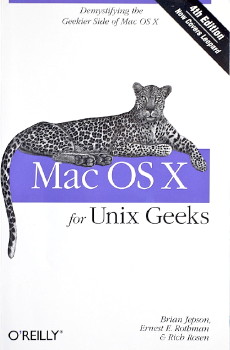|
|
Most users will be perfectly happy with the Mac's graphic user interface (GUI) and never feel the need to go any further. Nor is this necessary. To draw a parallel, a car owner does not need to know how to check the oil, nor the spark plugs, or even how to change a wheel. Some car users do, and some take it much further and can disassemble an engine if necessary. It is for their computer-owning cousins, that Mac OS X for Unix Geeks was written. A comment in the Preface pitches the book as a "bridge for Unix developers and system administrators who've been lured to Mac OS X because of its Unix roots." I have reviewed similar works like Jepson and Rothman's Mac OS X Panther for Unix Geeks, Running Mac OSX Panther by James Duncan Davidson and Learning Unix for Mac OSX Panther by Dave Taylor and Brian Jepson, but OS X itself has evolved. This new work, perfectly sub-titled, "Demystifying the Geekier side of Mac OS X", is a useful addition.
At 406 pages the book is some 40 pages bulkier than the Panther for Geeks issue of 2004 and there are several pages with new information. Part One for example has three new chapters (Searching and Metadata, Files and Filesystems, and Dual Boot and Beyond) as well as changes to other chapters reflecting additions and changes to OS X. The chapter on Perl formerly in Part Two is now in Part Four and has been expanded to include Python, Ruby and Java. Part Three still includes the excellent chapter on Fink, for compiling Open Source software to run on OS X, but has a new chapter on MacPorts, while the chapter on Packages has been rewritten and is now titled Creating and Distributing Installable Software. Each chapter is further split into shorter, more-easily assimilated sections. The text is peppered with side comments -- suggestions and warnings -- that bring out ideas extra to the text or caution about actions that users may take. There are also some additional text boxes providing useful information that does not integrate with the main idea being discussed: adding to its value as a reference work. The style of these additional comments will be familiar to anyone who has used works from O'Reilly before. Throughout the book there are several greyscale images (screenshots), where needed, to illustrate the text, which sometimes needs a second read before a complex process can be fully grasped. That is not a reflection on the writing skills of the authors, but the complexities of the information they are working with. There are also a number of useful tables throughout. A good example may be found in Chapter 3: Files and Filesystems. The data set out here explains the content of Root and then the important sub-directories of /etc, /dev, /var, /System/Library and /Library. For anyone trying to bridge that gap between using the GUI and successful use of the Unix, this table contains valuable information. Another example is on nvram variables, in the chapter on System management tools. These and others show that this is not simply a book to read but also confirming its reference values.
Even flipping through the pages, which is my initial approach to any work like this, one is likely to come across a new utility or a new idea that provides a better insight into how the whole thing works. Some chapters close with useful suggestions or links to further sources. Along with the Table of Contents and the Organization description, at the end is an appendix: Mac OS X GUI Primer, for those Unix users unfamiliar with OS X giving a brief (10 page) overview of OS X. This is followed by a comprehensive Index that begins with Symbols before the A - Z. Finally, there is information on the authors, followed by a colophon, in which the cover page design (in this case using a Leopard) is discussed.
|
|


